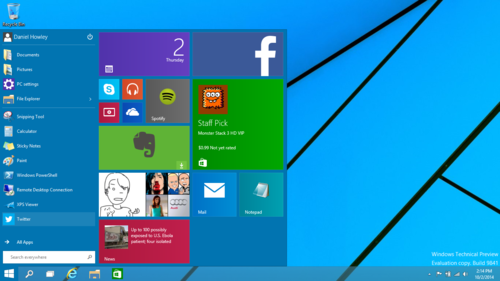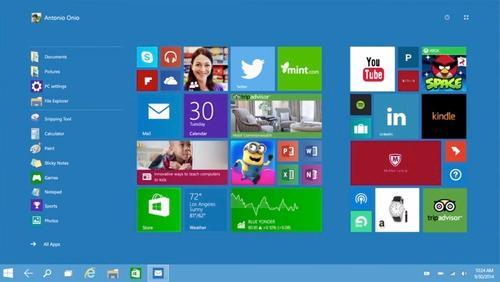WINDOWS 10
Windows 10 is an upcoming release of the Microsoft Windows operating system. Unveiled on September 30, 2014, it will be released in late 2015.
First teased in April 2014 at the Build Conference, Windows 10 aims to address shortcomings in the user interface first introduced by Windows 8 by adding additional mechanics designed to improve the user experience for non-touchscreen devices (such as desktop computers and laptops), including a revival of the Start menu seen in Windows 7, a virtual desktop system, and the ability to run Windows Store Apps within windows on the desktop rather than a full-screen mode.
These are the top reasons why Windows 10 looks like a winner for PC owners
1. The Start button is back.For years, the first
thing people saw when they booted their PCs was the humble Windows
Start button. But the little guy was nixed from Windows 8 in favor of
the Start screen.

With Windows 10, however, Microsoft is bringing back the Start
button. You can finally see all of your programs nested in its menus,
and shutting down is once again an easy click away.
What’s more, Windows 10 lets you add some of those nifty Windows 8 app tiles to the Start menu. It’s the best of both worlds.
2. The desktop returns.In Windows 8, the
traditional desktop took a backseat to the Start screen. Sure, you could
choose to boot to the desktop by fiddling with different settings, but
the emphasis was clearly on getting people to the Start screen.

The Start screen interface worked well with tablets, but Microsoft
wanted desktop and laptop owners to interact with the Start screen, too,
even if their computers didn’t have touchscreens.
Windows 10 puts the desktop back in its rightful place, front and
center as soon as you start up your computer. In fact, the touchy-feely
Start screen is entirely gone from the PC version. The only remnants of
the interface are the aforementioned app tiles that appear in the Start
menu.
3. Continuum mode.Microsoft hasn’t completely
axed the Start screen interface, though. It will still be available to
people who own 2-in-1 laptop-tablet hybrid computers.

The feature works by recognizing how you’re using your device. So if
you have a Surface Pro 3, for example, Windows 10 will run in tablet
mode, emphasizing the Start screen.
Connect the Surface’s keyboard attachment, however, and Windows 10
will switch over to desktop mode and all the features it includes.
4. Windows apps.Microsoft introduced its own
apps with Windows 8. And though they were beautiful, you could use them
only on the Windows 8 Start screen. Windows 10 changes that, letting you
open and use Windows 8 apps on the traditional desktop.

Better still, the apps don’t take up the whole screen anymore,
because they run in actual windows, meaning that you can move and resize
them as much as you want.
5. Snap your apps

Windows 8’s Snap feature, which lets you move apps to either side of
the screen, also returns in Windows 10. This time, though, you can snap
both Windows 8 apps and regular programs to either side of your screen.
It should make multitasking worlds better.
6. Task view.Windows 10’s new Task view is
similar to the Mission Control feature found in Apple’s OS X. From Task
view, you can open multiple desktops, each with their own apps. That
should help you crank your productivity up to 11 with ease.

What’s more, when you move your pointer over a desktop, you can see
what apps are running on it, so you don’t have to search each desktop to
find where you last left off.
The outlookWindows 8 has been a headache for
Microsoft, but Windows 10 is well on its way to righting its
predecessor’s wrongs. Still, there’s a long way to go before this
operating system is finished. We’ve only begun to scratch the surface of
what Windows 10 has to offer. But from what little we’ve seen,
Microsoft is on the right track.








